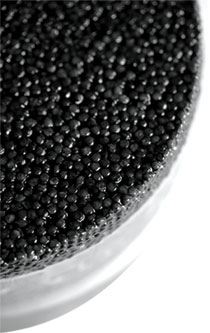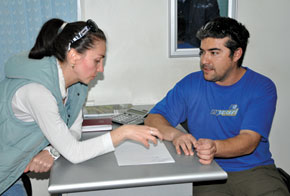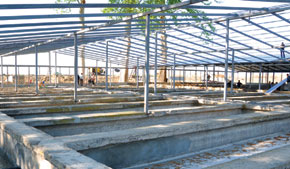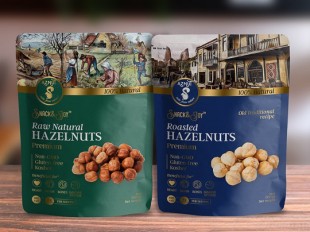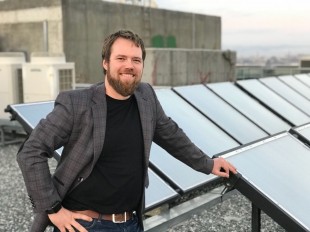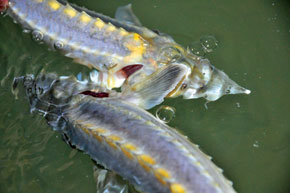 The Caspian Sea has always been known as a home to the sturgeon and the fish has iconic status in Azerbaijan. As it first appeared some 300-350 million years ago, it is indeed a venerable denizen of the deep.
The Caspian Sea has always been known as a home to the sturgeon and the fish has iconic status in Azerbaijan. As it first appeared some 300-350 million years ago, it is indeed a venerable denizen of the deep. Its antiquity and high commercial value are beyond doubt. No other fish is so highly prized for its caviar, quality of meat or range of industrial and medicinal substances extracted from the internal organs. However, overfishing has had a drastic effect on numbers. At present, the world’s largest sturgeon population (up to 80 per cent) is in the Caspian Sea, where it is represented by six species: Beluga, Barbel sturgeon, Russian sturgeon, Persian sturgeon, Starry sturgeon and Sterlet.
Rauf Hajiyev, Azerbaijan’s Deputy Minister of Ecology and Natural Resources told us said that as the one of the most ancient of fish species, sturgeons’ ability to adapt to changes in climate and environment had made them survivors. Although their numbers are now in decline, he expects that the future will see an improvement. He told us how this may be achieved in an interview with Visions of Azerbaijan (see page 80).
When sturgeon stocks came under threat in the mid 1990s, the republic of Azerbaijan, as one of the five Caspian littoral states, decided to declare a moratorium on sturgeon fishing. A number of fisheries have also been opened for the breeding of sturgeon fry, although the Ministry of Ecology and Natural Resources admits that there is currently a shortage of female sturgeons.
Trip to a fishery
The fishery for the raising of young fish which has been operating for four years in Mingechevir, is certainly recording some success in the search for a solution to the problem. Three types of fishes are farmed here: Carp, Silver Carp and Sturgeon. It all began with fry - imagine the tiny fry being brought to start-up the newly-constructed plant. As we found out, raising young fish is no easy matter and sturgeons are the trickiest. They are prone to attack by various microbes and diseases and demands constant attention, correct feeding and modern methods of disease prevention, as we saw in Mingechevir. The fishery was set up on the edge of Mingechevir’s reservoir, constructed on the Kur River and so large (70 km long) that locals refer to it as a sea, although it is, of course, a freshwater lake. When we arrived at the fishery gates on a hot, sunny day, it was as if the sun were shining on a bowlful of diamonds. Assistant Director Elnur Allakhverdiyev met us at the gates and took us into the fish production area.
Already four years have passed since we began fish production at this new plant. As you see construction work is still going on. We plan to increase production so we have started expanding the plant.
Welcome to the world of sturgeon
There were several sections in the plant. In the largest Elnur showed us dozens of small pools full of sturgeon of different ages. Here was one with fish 3-4 years old. Different ages are kept separate. The distinctive smell of fish was everywhere, as if announcing welcome to the world of sturgeon.
Production assistant Khalid Askerov was responsible for the fish in these pools. He told us that the sturgeon is the most fretful of the fish and they demanded patience and competence. He showed us the biggest sturgeon in the plant, a four year old weighing 20 kilos. Raffaello Osvaldo, an expert from Chile, has been at the plant since almost the start of production. He is responsible for the heating system and feeding.
Fish are like human beings. They need special care and scheduled feeding. For instance, 3 month-old fish need to be fed six times a day; at 5 months – three times a day; and one year old fish are fed just once a day. Water temperature always has to be regulated.
A walk by a fish ‘kindergarten’ and ‘hospital’
The plant seems to cover all aspects of life. You can find here a ‘kindergarten’ where young fishes gambol in the pool, or a special ‘hospital’ pool where ill fish are treated. We noted another space with special equipment for pairing fish off for reproduction. It was very interesting to see the similarities with human life. Walking through the different sections of the plant we finally came upon a room which had nothing to do with fish. This was for the staff – just four people. Comfortable armchairs, a table and even a TV set made the room comfortable. Here we met Ahikam Gissis, the plant’s senior expert who came from Israel as a consultant on feeding and treating fish.
The sturgeon needs special care
Over a cup of tea but with the all-pervasive aroma to keep us on topic, Ahikam told us about the intricacies and difficulties of raising sturgeon.
How do you feed the fish?
We import food. It is a special combination of ingredients, high in proteins and a variety of vitamins; it also has to be poorly soluble. We buy tons of it from large producers in Georgia, Israel and Greece to keep the fish in good condition.
How do you look after the fish? Is there a specific regime?
You know, there is a certain season when fish spawn. It starts in May and ends in October. In this period the fish demand special care. In winter, when there is no spawning, we concentrate on the growth of young fish. We feed them and take care of them by maintaining the necessary temperature in their pools. But this is a slow process, as the fish grow more in spring and summer than in winter. No matter how we feed a fish it has its own nature and biological clock. The best temperature range for growing sturgeon is from 19-27oC although they can grow in temperatures above 10o. In summer that is no problem, but in winter the heating necessary to maintain those temperatures is so expensive. But we do our best. Thus, we try to use natural resources and move fish to, let us call them, ‘summer camps’. These are special cages or cells in Mingechevir Lake where the fish spend the whole of spring and summer in natural conditions. No money, no energy – everything is natural. We have already installed a number of cages. We need more and we calculate that the costs of maintaining fish exceed the returns, so we try to reduce these costs to the minimum.
What is the fishery’s current stock of sturgeon?
Currently there are 4,000 tons of sturgeon within a weight range of 5-12 kgs. The are many more smaller ones. Each cage is planned to produce about 18 tons of fish every two years. That is a good number. Look, if the same number of fish were set up in water pools we would a huge area. But in the lake which is deeper than the pools and where the water is rich in minerals and oxygen, there is no problem with space. We just have to provide the food and fish will grow.
And you are going to increase production, aren’t you?
Yes, exactly. We’ve got big plans for the future. We are working now on installing the system of cages. Dozens of cells have already been installed in the lake, others are awaited. We also have another new fishery in Varvari village, not so far away. It is under construction and will be open by the summer. It will produce 750 tons of sturgeon annually.
Where do you sell the fish from the plant? Does it go to domestic or international markets?
The fish goes to both domestic and international markets. Our carp are only sold in Azerbaijan while sturgeon goes abroad. By the way, we are already selling to markets in the former Soviet area. We are also planning to produce perch and pike which are in huge demand in some European countries, like Italy, Germany and France. All exports go through the Caspian Fish Co. More than 90 per cent of fish are exported.
What about producing caviar?
The oldest fish in the plant is about four years old. They really need three more years before they start producing caviar. You see, it’s very hard to get fish from the Caspian Sea now; there are not so many. This is why we are trying to open more plants like this one. It will impact positively on the fish population, while pollution and other ecological problems have the opposite effect. We don’t have those problems in the lake yet, but with the likely increase in numbers of tourists we may face difficulties in the future. So we cooperate closely with the Ministry of Ecology and National Resources to try to resolve these things.
